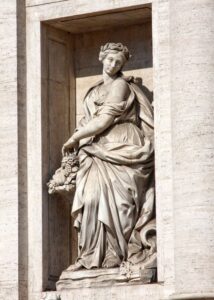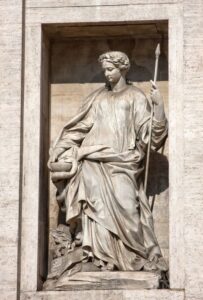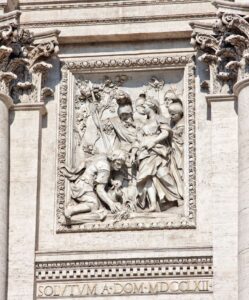.The Trevi Fountain

The Trevi Fountain’s location at the junction of three roads (tre vie) marks the traditional point where an ancient Roman aqueduct called the Aqua Virgo – the Virgin Water – made a hard right turn to get to the ancient city center after flowing south for many miles. Legend has it that a young woman showed some thirsty Roman soldiers a spring.
This spring, located approximately at the 8th milestone on the Via Collatina from the city’s 0 milestone in the Roman Forum became the source for the aqueduct. The aqueduct supplied a major bath complex. Marcus Agrippa financed both the aqueduct and the bath in 19 BCE. The source was only 8 miles (15 km) away but the run length of the aqueduct was over 20 km. It’s end-to-end drop was only 4 meters.
The Goth invaders cut the aqueduct in of 537/538 AD. Late Antiquity Rome’s citizens lost their last fresh water supply for 1 000 years. Pope Nicholas V repaired the aqueduct in 1453 and built a small simple basin at it’s terminus.
Commission and Construction
Pope Clement XII held a competition in 1730 for a fountain design to cover the entire back wall of the Palazzo Poli. Roman citizen Nicola Salvi won the competition and work commenced in 1732. It is in the Baroque style. The very last touches were applied to the fountain 30 years later with the installation of the statue of Oceanus (the god of all water) in the central niche.
Dimensions
The fountain is 20 meters (65 feet) wide and 26 meters (85 feet) high at it’s highest point. It is the largest Baroque fountain in Rome.
Iconography
 The central niche contains a statue of Oceanus.
The central niche contains a statue of Oceanus.
 The left niche has a statue of Abundance pouring water from her urn
The left niche has a statue of Abundance pouring water from her urn
 and the right niche a statue of Salubrity with a snake drinking from her cup.
and the right niche a statue of Salubrity with a snake drinking from her cup.
 The bas relief panel above the right side niche shows the young girl (the virgin of the spring) showing the Roman soldiers the spring.
The bas relief panel above the right side niche shows the young girl (the virgin of the spring) showing the Roman soldiers the spring.
Tossing the Coins
Various stories about tossing the coins in the fountain exist. The most common one is that one tosses a coin to ensure another visit to Rome. Extensions of that say 2 coins means one will fall in love and 3 coins means one will marry in Rome. Approximately 3 000 Euros are tossed into the fountain every day. The city of Rome collects the coins and gives them to various charities.
If you are planning a visit to Italy soon I have written 2 walking tour guide books to Rome that you can purchase here or at Amazon or Barnes and Noble.
I have an album of photos from Rome and other places in Italy in my photo gallery.
One thought on “The History of Rome – The Trevi Fountain”